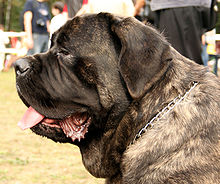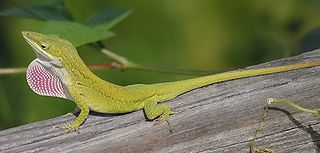
Dactyloidae are a family of lizards commonly known as anoles and native to warmer parts of the Americas, ranging from southeastern United States to Paraguay. Instead of treating it as a family, some authorities prefer to treat it as a subfamily, Dactyloinae, of the family Iguanidae. In the past they were included in the family Polychrotidae together with Polychrus, but the latter genus is not closely related to the true anoles.

Anolis is a genus of anoles, iguanian lizards in the family Dactyloidae, native to the Americas. With more than 425 species, it represents the world's most species-rich amniote tetrapod genus, although many of these have been proposed to be moved to other genera, in which case only about 45 Anolis species remain. Previously, it was classified under the family Polychrotidae that contained all the anoles, as well as Polychrus, but recent studies place it in the Dactyloidae.

Anolis carolinensis or green anole is a tree-dwelling species of anole lizard native to the southeastern United States and introduced to islands in the Pacific and Caribbean. A small to medium-sized lizard, the green anole is a trunk-crown ecomorph and can change its color to several shades from brown to green.

The brown anole, also known commonly as the Cuban brown anole, Bahaman anole, or De la Sagra's anole, is a species of lizard in the family Dactyloidae. The species is native to Cuba and the Bahamas. It has been widely introduced elsewhere, via the importation and exportation of plants where the anole would lay eggs in the soil of the pots, and is now found in Florida and other regions of the United States including southern Georgia, Texas, Louisiana, Tennessee, Mississippi, Alabama, Hawaii, North Carolina, and Southern California. It has also been introduced to other Caribbean islands, Mexico, and Taiwan.

The knight anole is the largest species of anole in the Dactyloidae family. Other common names include Cuban knight anole or Cuban giant anole, highlighting its native country, but it has also been introduced to Florida. In its native Cuba, this large anole is called chupacocote.

The blue anole is a species of lizard in the family Dactyloidae. A. gorgonae falls into the genus Dactyloa, which are all highly arboreal, but differ in size, coloration, and perch preferences. The blue anole specifically occupies higher perches. It is a small species which is "near threatened" and found only on the island of Gorgona, in the Colombian Pacific.

Anolis cristatellus is a small species of anole, belonging to the Dactyloidae family of reptiles. The species is native to Puerto Rico and the U.S. and British Virgin Islands, with introduced populations in locations around the Caribbean. The males of A. cristatellus are easily recognizable by the fin running down the top of the tail, which is known as a "caudal crest". The females also have this crest, but it is smaller than that of the males. The species is often quite common in many areas on Puerto Rico, where it can be seen during the day passing the time on the lower parts of tree trunks, or on fences and the walls of buildings in urban areas, sometimes venturing down onto the ground in order to lay eggs, have a snack, or do other cursorial activities. Like many anoles, this species displays the characteristic behaviour of doing push-ups as well as inflating a pizza-like flap of coloured skin on its throat, known as a dewlap, in order to show others how dominant it is, and thus attract mates or intimidate rivals.
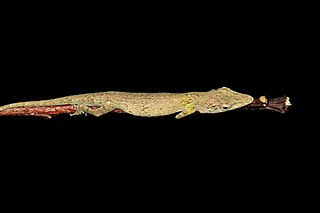
The Puerto Rican twig anole or dwarf anole is a species of small, arboreal anole endemic to Puerto Rico and primarily inhabiting the Cordillera Central from the Sierra de Cayey range in the Southeast to the central-western ranges of Maricao. A mostly grey to olive-brown bodied lizard, A. occultus is the smallest of the Puerto Rican anoles with a snout to vent length of 34–42 mm. In comparison to other twig anoles, A. occultus is extremely cryptic through its unique sleeping behaviors and mottled pattern. Sleeping behavior including site selection minimizes the probability of predator encounter along with A. occultus' extensive list of antipredator behaviors.

Anolis roquet, also called Martinique anole, Martinique's anole, or savannah anole, is a species of anole lizard. It is endemic to the island of Martinique, located in the Caribbean Lesser Antilles.

Microlophus occipitalis, colloquially known as the knobbed Pacific iguana, is a lizard included within the Tropiduridae family. It is a member of the Microlophus genus and thus also considered a lava lizard. The knobbed Pacific iguana is found primarily in Western Peru and Ecuador, lining the coasts. The habitats of the knobbed Pacific iguana can be considered to be both broad and diverse as they are typically found in many different places such as beaches, lomas, and all the way to desert regions. This diversity is furthered as these lizards can also be found in open areas, between rocks, or bushes.

A caruncle is defined as 'a small, fleshy excrescence that is a normal part of an animal's anatomy'. Within this definition, caruncles in birds include wattles, combs, snoods, and earlobes. The term caruncle is derived from Latin caruncula, the diminutive of carō, "flesh".

Anolis grahami, commonly known as the Jamaican turquoise anole and Graham's anole, is a species of lizard in the family Dactyloidae. The species is native to the island of Jamaica, and has also been introduced to the territory of Bermuda. It is one of many different species of anole lizards found in Jamaica. There are two recognized subspecies.

Anolis cuvieri is a species of lizard in the family Dactyloidae. The species is endemic to Puerto Rico, and is common in the Toro Negro State Forest.

Anolis proboscis, commonly known as the horned anole, Ecuadorian horned anole or Pinocchio lizard, is a small anole lizard in the family Dactyloidae. A single male specimen was discovered in 1953 in Ecuador and formally described by Peters and Orces in 1956, but the species then went unreported until its rediscovery in 2004. Its currently known habitat is a small stretch of vegetation along an Ecuadorian highway. It has been classified as Endangered by the IUCN due to its restricted distribution and ongoing habitat loss.

Anolis stratulus is a moderately-sized species of anole found in Puerto Rico, the United States Virgin Islands and the British Virgin Islands. It is a gray-colored lizard spotted with brown markings. It is arboreal, usually found positioned on tree bark on branches in the canopies of forest trees, where in some areas of Puerto Rico it can be incredibly abundant, with tens of thousands of the lizards being present per hectare.
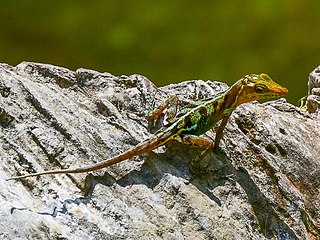
Anolis vermiculatus, the Vinales anole or Cuban stream anole, is a species of lizard in the family Dactyloidae, endemic to Cuba.

Anolis aquaticus, commonly known as the water anole, is a semi-aquatic species of anole, a lizard in the family Dactyloidae, native to southwestern Costa Rica and far southwestern Panama. The species demonstrates adaptations that allows it to spend periods of time underwater up to approximately a quarter of an hour, forming an air bubble which clings to its head and serves to recycle the animal's air supply while it spends time beneath the surface. Although highly unusual, similar adaptions and behavior are found in other species of semi-aquatic anoles.

Anolis auratus, the grass anole, is a species of lizard in the family Dactyloidae. The species is found in Costa Rica, Panama, Venezuela, Colombia, French Guiana, Guyana, and Brazil.
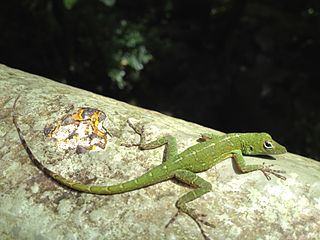
Anolis evermanni, also known commonly as the emerald anole, Evermann's anole, and the small green anole, is a species of lizard included within the family Dactyloidae. A. evermanni is native to Puerto Rico, where it is mainly found in wet forests. A. evermanni is a medium-sized lizard and bright emerald-green in color. A. evermanni is studied for its behavior as well as the evolution of the family Dactyloidae. The group of lizards which are member species of the family Dactyloidae are known as anoles. Anoles are found throughout the Americas and are related to iguanas.

Anolis lemurinus, the ghost anole, is a species of lizard in the family Dactyloidae. The species is found in Mexico, Guatemala, Belize, El Salvador, Honduras, Nicaragua, Costa Rica, Panama, and Colombia.
